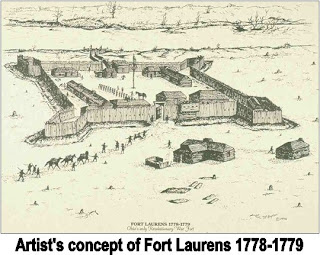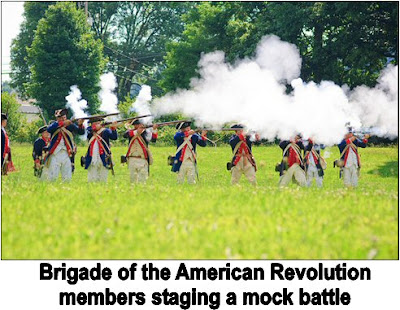History to Come Alive at Fort Laurens
Pictured is a selection of some of the nearly 300 pieces of lead ammunition and miscellaneous scrap from a deposit excavated at Fort Laurens near Bolivar, Ohio by Ohio Historical Society archaeologists and volunteers in 2004. The ammunition deposit was likely a remnant of a March 1779 pack horse stampede that occurred just as a relief column arrived at the beleaguered frontier outpost. Just how the deposit came to be is a prime example of just when you think absolutely nothing more can go wrong you can always depend on Murphys Law.

 Fort Laurens was constructed in the fall of 1778 during the American Revolution as part of a strategic American campaign against the British stronghold at Detroit. It had been planned that an American army of some 1200 soldiers and militia led by General Lachlan McIntosh would march from Fort Pitt, through northern Ohio and attack Fort Detroit from where the British had been directing the war along the northwestern frontier. Due to inclement weather and a particularly early winter it was decided that the army would halt its march in northeast Ohio and construct an outpost along the west bank of the Tuscarawas River, mostly as a way station and a jumping off point to continue the campaign in the spring.
Fort Laurens was constructed in the fall of 1778 during the American Revolution as part of a strategic American campaign against the British stronghold at Detroit. It had been planned that an American army of some 1200 soldiers and militia led by General Lachlan McIntosh would march from Fort Pitt, through northern Ohio and attack Fort Detroit from where the British had been directing the war along the northwestern frontier. Due to inclement weather and a particularly early winter it was decided that the army would halt its march in northeast Ohio and construct an outpost along the west bank of the Tuscarawas River, mostly as a way station and a jumping off point to continue the campaign in the spring.
The fort was named Fort Laurens in honor of Henry Laurens, McIntosh’s friend and benefactor and president of the first Continental Congress. Soon after its completion the bulk of the army returned to the east leaving a garrison of just under 200 to man the fort. From the beginning the fort was under supplied in even the most basic necessities. After an ambush and massacre of a wood gathering party in February 1779 the forts garrison believed that it was surrounded by an overwhelming combined force of British and their Indian allies and remained holed up inside the fort, unable to venture out even to hunt. As a result the garrison had to subsist on what scant supplies they had on hand and were soon reduced to grubbing for roots and grasses growing along the fort walls. It was said that the conditions soon became such that the soldiers even attempted to make a weak broth by boiling their moccasins. This state of near starvation went on for nearly a month until a relief column finally arrived from the east. The garrison was so overwhelmed by the sight of the pack train that the first thing they did was fire a musket volley or feu de joie as a salute. A hugely unexpected consequence of the musket blasts was that it startled the pack horses, causing them to bolt in a stampede and drop their supplies for miles over the countryside. It was this incident that likely produced the deposit of lead shot unearthed in 2004.
 With his supplies scattered and lost forever McIntosh quickly realized his dreams of conquest and glory were dashed. Interestingly enough within a few days of the wood cutters massacre, George Rogers Clark captured Fort Sackville at Vincennes and in large part secured the northwest frontier for the American cause. With war aims now focused elsewhere Fort Laurens was seen as no longer necessary and it was abandoned in the summer of 1779.
With his supplies scattered and lost forever McIntosh quickly realized his dreams of conquest and glory were dashed. Interestingly enough within a few days of the wood cutters massacre, George Rogers Clark captured Fort Sackville at Vincennes and in large part secured the northwest frontier for the American cause. With war aims now focused elsewhere Fort Laurens was seen as no longer necessary and it was abandoned in the summer of 1779.
This weekend July 14thand 15th 2012, there will be an encampment of the Brigade of the American Revolution at Fort Laurens. Brigade members are modern day re-enactors dedicated to preserving the Revolutionary spirit and bringing the past to the present with displays and demonstrations of weapons used during the Revolution, marching and close order drills, mock battles and skirmishes and keeping authentic camps. It is well worth the trip to see how things in the good old days really were and to get an idea how the forces that helped found this country actually operated.
Fort Laurens is located off I-77 at Bolivar, Ohio in northeast Ohio, just south of Canton. Activities last from 10:00 to 5:00 both days. Admission is $7.00 for adults and $3.00 for children.
Don’t worry; there are plenty of places to eat in the area so your moccasins are safe!
Bill Pickard

 With his supplies scattered and lost forever McIntosh quickly realized his dreams of conquest and glory were dashed. Interestingly enough within a few days of the wood cutters massacre, George Rogers Clark captured
With his supplies scattered and lost forever McIntosh quickly realized his dreams of conquest and glory were dashed. Interestingly enough within a few days of the wood cutters massacre, George Rogers Clark captured